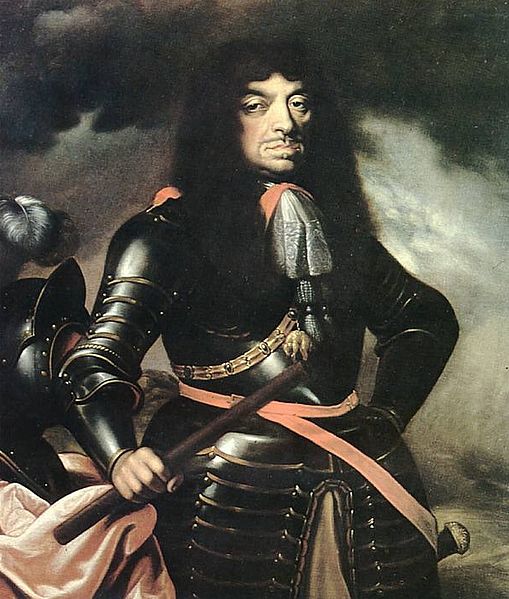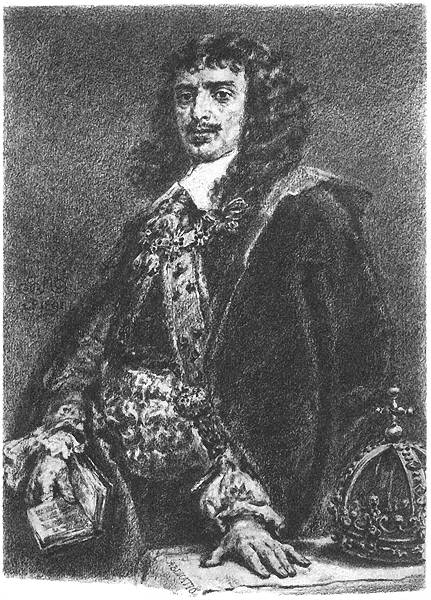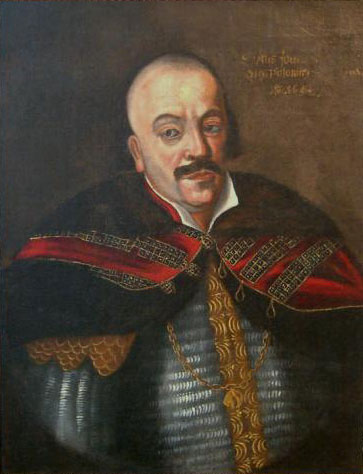<Back to Index>
- King of Poland Jan II Kazimierz Wasa, 1609
PAGE SPONSOR



John II Casimir (Polish: Jan II Kazimierz Waza; German: Johann II. Kasimir Wasa; Lithuanian: Jonas Kazimieras Vaza (22 March 1609 – 16 December 1672) was King of Poland and Grand Duke of Lithuania during the era of the Polish – Lithuanian Commonwealth, Duke of Opole in Upper Silesia, and titular King of Sweden 1648 – 1660. In Poland, he is known and commonly referred to as Jan Kazimierz. His parents were Sigismund III Vasa (1566 – 1632) and Constance of Austria (1588 – 1631). His older brother, and predecessor on the throne, was Władysław IV Vasa. Related to the Habsburg rulers of the Holy Roman Empire he was the third and last monarch on the Polish throne from the House of Vasa. He was the last ruler of Polish – Lithuanian Commonwealth bearing a dynastical blood of the House of Gediminas and a branch of it, the Jagiellons, although from female line.
- Official titles in Latin: Ioannes Casimirus, Dei Gratia rex Poloniae, magnus dux Lithuaniae, Russie, Prussiae, Masoviae, Samogitiae, Livoniae, Smolenscie, Severiae, Czernichoviaeque; nec non Suecorum, Gothorum, Vandalorumque haereditarius rex, etc.
- English translation: John Casimir, by God's grace King of Poland, Grand Duke of Lithuania, Ruthenia, Prussia, Masovia, Samogitia, Livonia, Smolensk, Severia and, Chernihiv; and also hereditary King of the Swedes, Goths and Vandals.
His father Sigismund, grandson of Gustav I of Sweden, had in 1592 succeeded his own father to the Swedish throne, only to be deposed in 1599 by his uncle, Charles IX of Sweden. This led to a long standing feud wherein the Polish kings of the House of Vasa claimed the Swedish throne, resulting in the Polish – Swedish War of 1600 – 1629. Poland and Sweden were also on opposite sides in the Thirty Years' War (1618 – 1648), although in that war Poland for the most part avoided taking part in any major military actions.
John Casimir for most of his life remained in the shadow of his brother, Władysław IV Waza. He had few friends among the Polish nobility (szlachta), as he openly sympathized with Austria and showed disregard and contempt for Polish culture. Unfriendly, secretive, dividing his time between lavish partying and religious contemplation, and disliking politics, he did not have a strong power base nor influence at the Polish court. He did display talent as a military commander, showing his abilities in the Smolensk War against Muscovy (1633). Between 1632 and 1635, Władysław IV sought to enhance his brother's influence by negotiating a marriage for John Casimir to Christina of Sweden, then to an Italian princess, but to no avail. In 1637 John Casimir undertook a diplomatic mission to Vienna, which he abandoned to join the army of the Holy Roman Empire and fight against the French. After his regiment was defeated in battle, he spent a year living lavishly at the Viennese court.
In 1636 he returned to the Polish – Lithuanian Commonwealth and fell in love with Baroness Guldentern, but his desire to marry her was thwarted by King Władysław. In return, Władysław attempted to make him the sovereign of Courland, but this was vetoed by the Commonwealth parliament (Sejm). Taking offense at this, John Casimir in 1638 left for Spain to become Viceroy of Portugal, but was captured by French agents and imprisoned by order of Cardinal Richelieu until 1640. He was then freed by a diplomatic mission of the Voivod of Smolensk, Aleksander Gosiewski.
In 1641 John Casimir decided to become a Jesuit. In 1642 he again left the Polish – Lithuanian Commonwealth, accompanying his sister to Germany. In 1643 he joined the Jesuits, against vocal opposition from King Władysław, causing a diplomatic rift between the Commonwealth and the Pope. John Casimir was made a cardinal, but in December 1646, finding himself unsuited to ecclesiastical life, he returned to Poland. In October 1647 he resigned as cardinal to stand in elections for the Polish throne. He attempted to gain the support of the Habsburgs and marry an Austrian princess.
In 1648 John Casimir was elected to succeed his
nephew - by - second - marriage on the Polish throne. The reign of the
last of the Vasas in the Polish – Lithuanian Commonwealth would be
dominated by
the Russo - Polish War (1654 – 1667), followed by the war with Sweden ("The Deluge"),
the scene for which had been set by the Commonwealth's two previous
Vasa kings. Most of Poland was invaded by the Swedish army during the
Deluge without much of a fight, due to the conspiratorial complicity of
Polish and Lithuanian governors and nobility. In the course of a few
years, the Commonwealth rose to force the Swedes out of Poland, ending
the short lived intrusions and campaigns.
In 1660 John II Casimir was forced to renounce his claim to the Swedish throne and acknowledge Swedish sovereignty over Livonia and the city of Riga.
John Casimir had married his brother's widow, Marie Louise Gonzaga (Polish: Maria Ludwika), who was a major support to the King. Marie Louise died in 1667.
On 16 September 1668, John II Casimir abdicated the Polish – Lithuanian
throne, and returned to France, where he joined the Jesuits and became
abbot of Abbey of Saint - Germain - des - Prés in Paris. He died in 1672.
John Casimir left no surviving children. All his brothers and sisters having predeceased him without surviving issue, he was the last of the line of Bona Sforza. With him, all the legitimate issue of Alfonso II of Naples died out. His heir in Ferdinand I of Naples and in the Brienne succession was his distant cousin, Henry de La Tremoille, Prince of Talmond and Taranto, the heir - general of Frederick IV of Naples (second son of Ferdinand I of Naples and Isabella of Taranto), who also was the heir - general of Federigo's first wife, Anne of Savoy.
John Casimir was, after his brother, the head of the genealogical line of St.Bridget of Sweden,
descending in primogeniture from Bridget's sister. After his death, the
headship was inherited by his second cousin, the already abdicated Christina I of Sweden.
The collection of the Polish Vasas was looted by Swedes and Germans of Brandenburg who brutally sacked Warsaw in 1650s, during the Deluge. Though some of works survived hidden in Opole like The Rape of Europa by Guido Reni.
The most important additions to the collection were made by John II Casimir a passionate collector of Dutch paintings, and a patron of Daniel Schultz (who painted a famous portrait of a son of Crimean Aga Dedesh, made Royal falconer in reward for his father's contribution in war with Russia in 1663). Major part of king's painting collection was acquired in 1660s, using an agent in Amsterdam, Hendrick van Uylenburgh and later his son Gerrit van Uylenburgh, mainly Dutch paintings and works by Rembrandt. The collection also included works by Rubens, Jordaens, Reni, Guercino, Brueghel, Bassano among others.
When John Casimir abdicated the Polish – Lithuanian throne, he took to France a large number of his paintings. The collection remaining at Royal Castle in Warsaw was looted during the Great Northern War or appropriated in 1720 by Frederick Augustus I, Elector of Saxony, like two paintings by Rembrandt - Portrait of a Bearded Man in Black Beret (1657 also known as the Portrait of a Rabbi) and Portrait of a Man in the Hat Decorated with Pearls (1667), today displayed in the Gemäldegalerie Alte Meister in Dresden, Germany.